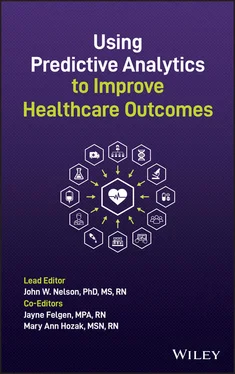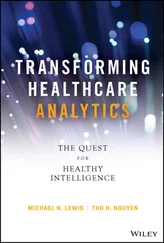Using Predictive Analytics to Improve Healthcare Outcomes
Здесь есть возможность читать онлайн «Using Predictive Analytics to Improve Healthcare Outcomes» — ознакомительный отрывок электронной книги совершенно бесплатно, а после прочтения отрывка купить полную версию. В некоторых случаях можно слушать аудио, скачать через торрент в формате fb2 и присутствует краткое содержание. Жанр: unrecognised, на английском языке. Описание произведения, (предисловие) а так же отзывы посетителей доступны на портале библиотеки ЛибКат.
- Название:Using Predictive Analytics to Improve Healthcare Outcomes
- Автор:
- Жанр:
- Год:неизвестен
- ISBN:нет данных
- Рейтинг книги:5 / 5. Голосов: 1
-
Избранное:Добавить в избранное
- Отзывы:
-
Ваша оценка:
- 100
- 1
- 2
- 3
- 4
- 5
Using Predictive Analytics to Improve Healthcare Outcomes: краткое содержание, описание и аннотация
Предлагаем к чтению аннотацию, описание, краткое содержание или предисловие (зависит от того, что написал сам автор книги «Using Predictive Analytics to Improve Healthcare Outcomes»). Если вы не нашли необходимую информацию о книге — напишите в комментариях, мы постараемся отыскать её.
Discover a comprehensive overview, from established leaders in the field, of how to use predictive analytics and other analytic methods for healthcare quality improvement. Using Predictive Analytics to Improve Healthcare Outcomes
before
proven in advance
Using Predictive Analytics to Improve Healthcare Outcomes
Using Predictive Analytics to Improve Healthcare Outcomes — читать онлайн ознакомительный отрывок
Ниже представлен текст книги, разбитый по страницам. Система сохранения места последней прочитанной страницы, позволяет с удобством читать онлайн бесплатно книгу «Using Predictive Analytics to Improve Healthcare Outcomes», без необходимости каждый раз заново искать на чём Вы остановились. Поставьте закладку, и сможете в любой момент перейти на страницу, на которой закончили чтение.
Интервал:
Закладка:
A memorable example of interdisciplinary impact on outcomes was the presumably “cost‐effective” decision to change the color of caps used for central lines. Although to the products and purchasing team it was just a color, and the yellow ones were less expensive than the green ones, they had no idea the impact the change in cap color would make on our infection control practices. After the cap change, the catheter‐associated infections in the ICU began to rise, and it was not until the interdisciplinary team dove deeply into the discussion of line maintenance, and then finally down to cap use (an element rarely thought of), that we discovered what had gone wrong. It was becoming clearer to people throughout the organization that everybody's input matters.
Although to the products and purchasing team it was just a color, and the yellow caps were less expensive than the green caps, they had no idea the impact the change in cap color would make on our infection control practices.
Key Success Factors
There are two key success factors that I would recommend to organizations pursuing the sort of quality improvement work outlined in this chapter. They are (a) hiring nurses with MSN and BSN degrees to work as PSI RNs, and (b) using recognition as an incentive for the good work done on quality improvement projects.
Education Levels of PSI RNs
Advanced practice nurses and clinical staff members with baccalaureate or master's‐level education have been taught to be consistent in asking the “why” and “how” questions that need to be asked in the data analysis process. When the question arises: “Did we look at this specific factor?” these highly prepared clinicians tap into their knowledge of the subject and ask the necessary questions to get at meaningful, actionable data that can be used to improve care outcomes. Leaders need to advocate for nurses who are hired as PSI RNs and into other performance improvement positions, to be MSN and BSN level nurses, and they must support nurses at all levels of preparation in seeking continuing education in areas such as statistics, research, ethics, and practice standards. (Fun fact: Our PhD prepared data analyst was once an associate nurse.) This emphasis will promote sustainability and encourage a culture of innovation.
Recognition of Excellence
Staff recognition is also crucial to sustaining the changes that bring about improved outcomes. When a staff council makes a change that improves practice, giving thank‐you notes, awards, and parties lets staff members know they are appreciated for the great work they have done. Be as specific as possible in your expressions of appreciation, focusing on specific improvements in practice and changes people have made that are meaningful to professional care. When staff members are recognized, they are motivated to keep working to improve things. They are proud of the outcomes they have achieved, and they love to know that leaders are also proud of them.
Summary
Healthcare is now very competitive, and the public often chooses healthcare based on online consumer advocacy resources. Improved outcomes help the organization score well with online resources such as Leapfrog and Hospital Compare, negotiate with payor sources, and even successfully achieve Magnet recognition. All of these financial benefits and awards are dependent upon having good and accurate data, but the true benefit and highest reward come from refinement of a caring environment for the patients and families where safety and quality come first.
As you dig into the case studies in this book, take with you the assurance that all of the work described in those case studies is within reach for you and your organization, too. If we can do it, you can do it.
4 Leadership for Improved Healthcare Outcomes
Linda Valentino and Mary Ann Hozak
All of the improved healthcare outcomes reported in this book can be traced back to a leader who understood that data must resonate with people. Data engages people when it is generated using measurement instruments specified to capture data that paints a picture of the organizational culture and associated operations. Highly specified data inspires action because it shows staff members what they are already doing well or need to fix to achieve improved operations and outcomes. When we, the authors of this chapter, share specific, recognizable, highly relevant data with staff members, they are most often at the edge of their seats. As they listen for the next piece of data, they anticipate the discussion because they already have ideas to improve operations. This chapter shares how leaders in healthcare organizations used data to make carefully targeted operational changes to improve outcomes.
Both of us have worked closely with a data analyst and have learned from him not only how to identify patterns within our data that reveal what is really going on operationally, but even more vitally, the importance of giving staff members access to data that really resonates for them. Once leaders from every level in the organization are working to tell their story more completely using data, and prioritizing their actions accordingly, widespread cultural and operational transformation begins.
Data as a Tool to Make the Invisible Visible
Data can help you identify leadership or teamwork issues such as incivility, and it can help bring factual realities into difficult conversations. What follows are two ways that data rather predictably reveals issues in organizations and units across the world, and one example of how the use of data can help facilitate difficult conversations.
Identifying a Bully
In the United States, the term “bully” refers to an employee who harasses or even abuses other coworkers (Lever, Dyball, Greenberg & Stevelink, 2019). Data derived from the Healthcare Environment Survey (HES), which measures nurse job satisfaction, behaves in a particular way when a bully is present. If satisfaction with coworker relationships is low and variables such as professional growth and satisfaction with patient care are high, it indicates that there is a bully on the unit. It is unknown how many times this pattern has been identified, but it has always proven to foretell the presence of a bully. (The data analyst can look at your data and tell you have a bully on your unit before he even visits.) It is also always the case that when this data is presented to the staff, the staff members all look at one another, knowing who the bully is, but not saying anything. The revelation of such data gives leaders greater urgency to address the issue. Bullies create chaos where they work, which causes relational distress for everyone. It is also the experience of the analyst that bullies typically work in pairs, with one person instigating the bullying behavior and the other coworker facilitating it. While it is often very difficult to move a bully out of an organization entirely, once the presence of a bully is revealed to all, action can usually be taken to start remedying the situation.
Managers Who Are “Buddies”
Another issue that can be identified by use of the HES is managers who are reluctant to enforce policies because they are too eager to be liked by their staff. Again, using the HES job satisfaction data, when the score for satisfaction with “relationship with unit manager” is high but all 10 of the other aspects of job satisfaction are noticeably lower, it is often because the unit manager has become “one of the gang” and is not tending to the work of actually leading the unit. In this “manager‐as‐buddy” scenario, it is also usually the case that the manager complains along with the employees and does not hold the staff accountable to follow policy, or understand their role, or accountability, or what their level of authority is in terms of patient care.
Читать дальшеИнтервал:
Закладка:
Похожие книги на «Using Predictive Analytics to Improve Healthcare Outcomes»
Представляем Вашему вниманию похожие книги на «Using Predictive Analytics to Improve Healthcare Outcomes» списком для выбора. Мы отобрали схожую по названию и смыслу литературу в надежде предоставить читателям больше вариантов отыскать новые, интересные, ещё непрочитанные произведения.
Обсуждение, отзывы о книге «Using Predictive Analytics to Improve Healthcare Outcomes» и просто собственные мнения читателей. Оставьте ваши комментарии, напишите, что Вы думаете о произведении, его смысле или главных героях. Укажите что конкретно понравилось, а что нет, и почему Вы так считаете.












